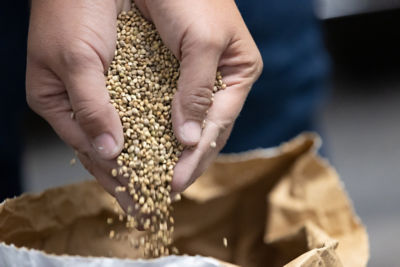Click here to download a PDF version of this spotlight.
» Bacterial canker and bacterial wilt result from the systemic infection of the vascular system of tomato plants.
» Disruption of the vascular system leads to wilt and possibly plant death.
» Management efforts should focus on integrated strategies to prevent infection.
BACTERIAL CANKER
Bacterial canker (caused by Clavibacter michiganensis subsp. michiganensis) is one of the most destructive bacterial diseases of tomato. Both primary (systemic) and secondary (foliar) infections result in significant reductions in yield and fruit quality. Primary infections start from infected seed or young seedlings. The pathogen enters the vascular tissue, which results in systemic wilting of the plant. Wilting starts on the lower leaves and progresses upward in the canopy, sometimes showing wilting on one side of the plant.1,2
 Figure 1. Internal discoloration of stem tissue from systemic bacterial canker infection. Gerald Holms, California Polytechnic State University at San Luis Obispo. Bugwood.org.
Figure 1. Internal discoloration of stem tissue from systemic bacterial canker infection. Gerald Holms, California Polytechnic State University at San Luis Obispo. Bugwood.org.
Young plants can wilt rapidly and eventually die while older plants usually wilt but remain alive. When leaflets wilt, the petioles stay attached and turgid. A light brown discoloration of the vascular tissue develops, most prominently at the nodes and just above the soil line. With time this discoloration becomes a dark reddish-brown (Figure 1). Light streaks may be visible externally on the stems, and these can darken and become cankers as the plant ages. Bird’s-eye spots (Figure 2) develop on the fruit. These spots are 3 to 6 mm in diameter with brown centers surrounded by creamy-white halos.1,2
 Figure 2. Bird’s-eye spots on tomato fruit infected with bacterial canker. Mary Ann Hansen, Virginia Polytechnic Institute and State University. Bugwood.org.
Figure 2. Bird’s-eye spots on tomato fruit infected with bacterial canker. Mary Ann Hansen, Virginia Polytechnic Institute and State University. Bugwood.org.
Spread of the pathogen from plant to plant in the field results in foliar infections, which result in leaves becoming chlorotic with brown-black margins. This secondary spread can also cause the bird’s-eye fruit spotting, but no wilting or vascular discoloration will occur.2 The greatest yield losses result from the primary infection of seedlings. Secondary (foliar) infection may not result in substantial reductions in yield or quality.
The bacterial canker pathogen overwinters on and in contaminated seed, in infested plant debris, and on volunteer tomatoes and weed hosts. Depending on conditions, the bacterium can survive for 1 to 2 years on crop debris. The bacterium can also survive on contaminated wooden stakes, seedling flats, and greenhouse benches used for transplant production. The pathogen is spread by splashing water and on contaminated tools.1 The bacterium infects the plant through natural openings, root wounds, and pruning wounds.2
MANAGEMENT OF BACTERIAL CANKER
The strategies used for managing bacterial canker are similar to those used to manage bacterial spot and speck. The most critical strategy is the use of disease-free seed and transplants. With bacterial canker, one infected seed in 10,000 is enough to initiate an epidemic. Seed should be disinfested with hot water, rather than with chlorine or acid treatments because the pathogen can be present under the seed coat where chlorine and acid cannot reach. The seed should be tested for the presence of the bacterium after treatment. If purchasing treated seed from a supplier, growers should ask what treatments were used, what procedures were used to ensure that all seed were adequately treated, if disinfesting solutions were monitored and how often, and if treated seed lots were tested for the presence of the pathogen.2
Sanitation is important during transplant production. All plant material should be removed from the greenhouse before starting a new crop of seedlings. Weeds and volunteers in and around the greenhouse should be eliminated. Growth media should be sterilized, and previously used flats, pots, racks, and stakes should be disinfested. Tools and greenhouse surfaces should be cleaned and treated with a disinfectant. Avoid contact between seedlings from different seed lots, and minimize the handling of seedlings. Choose irrigation methods and schedules to minimize the hours of leaf wetness. Do not handle wet plants, and allow plants to dry before transporting them to the field. Remove and destroy symptomatic seedling and any seedling trays immediately adjacent to the trays containing infected plants.1,2
In the field, eliminate solanaceous weeds and volunteer tomato plants. Plow under crop debris shortly after the last harvest. Rotate fields to non-solanaceous crops. For canker, a 3- to 4-year rotation away from solanaceous crops is recommended. Promote good water drainage, and, if possible, plant seedlings from different seed lots in different locations. Whenever possible, keep workers out of the fields when foliage is wet, and avoid pruning plants when leaves are wet. Avoid the use of overhead irrigation if possible; if not, use low-pressure systems that minimize the spread of bacteria through splashing. Carefully rogue-out and destroy symptomatic plants. Clean equipment and tools between plantings.1,2,3
BACTERIAL WILT
Bacterial wilt (caused by Ralstonia solanacearum) is a devastating disease of tomatoes in the warm, subtropical regions where it occurs. The disease initially appears as a wilting of the youngest leaves, quickly followed by a complete wilt of the entire plant (Figure 3). If the development of wilt progresses slowly enough, adventitious roots can form on the stems.
Bacterial wilt is favored by warm temperatures, and the disease occurs in the southern growing regions of the United States. The wilt pathogen has a very broad host range, infecting several hundred plant species in over 50 different plant families. The bacterium can also survive in the soil for extended periods in the absence of a susceptible host, obtaining nutrients from the root systems of non-host plants. High pH and calcareous soils are not favorable for the survival of this pathogen.1
The pathogen is introduced to a field in infested soil, in contaminated irrigation water, or on infected transplants. Seed transmission is not considered to be important for this disease. The pathogen infects plants through root wounds. After infection, the bacterium enters the xylem (water conducting tissue) where the bacterium multiplies and clogs the xylem elements, slowing the movement of water in the plant, resulting in wilting. Disease development is favored by high temperatures (82 °F to 95 °F) and high soil moisture levels.1
 Figure 3. Symptoms of bacterial wilt on tomato. Don Ferrin, Louisiana State University. Bugwood.org.
Figure 3. Symptoms of bacterial wilt on tomato. Don Ferrin, Louisiana State University. Bugwood.org.
Bacterial wilt is difficult to manage once the pathogen becomes established in a field. No single management strategy will provide adequate levels of control. The primary focus should be on preventing the introduction of the pathogen in infested soil, contaminated irrigation water, and infected transplants. Field tools and equipment should be thoroughly washed before moving from a contaminated field to a disease-free one. Contaminated pond water should be treated with chlorine to eliminate the pathogen. Some wilt-resistant varieties of tomato are available, but these can quickly become ineffective when new strains of the pathogen are present. Crop rotation to non-host crops, especially grasses such as sorghum-sudangrass and corn, can help lower pathogen populations, as will liming the soil to increase the soil pH. Avoid over irrigating the crop.1
SOURCES
1 Jones, J., Zitter, T., Momol, T., and Miller, S. 2014. Compendium of tomato diseases and pests, second edition. American Phytopathological Society, St. Paul, MN.
2 LeBoeuf, J., Cuppels, D., Dick, J., Loewen, S., and Celetti, M. 2005. Bacterial diseases of tomato: bacterial spot, bacterial speck, bacterial canker. OMAFRA FactSheet, ISSN 1198-712X.
3 Saha, S., Pfeufer, E., Bessin, R., Wright, S., and Strang, J. 2016. Vegetable production guide for commercial growers, 2016-17. University of Kentucky, Cooperative Extension Service. ID-36.
ADDITIONAL INFORMATION
For additional agronomic information, please contact your local seed representative. Developed in partnership with Technology Development & Agronomy by Monsanto.
Individual results may vary, and performance may vary from location to location and from year to year. This result may not be an indicator of results you may obtain as local growing, soil and weather conditions may vary. Growers should evaluate data from multiple locations and years whenever possible. The recommendations in this article are based upon information obtained from the cited sources and should be used as a quick reference for information about bacterial diseases of tomato. The content of this article should not be substituted for the professional opinion of a producer, grower, agronomist, pathologist and similar professional dealing with this specific crop.
SEMINIS DOES NOT WARRANT THE ACCURACY OF ANY INFORMATION OR TECHNICAL ADVICE PROVIDED HEREIN AND DISCLAIMS ALL LIABILITY FOR ANY CLAIM INVOLVING SUCH INFORMATION OR ADVICE. 161028162428 031317DME



